
For this edition of Classic Steel, we are going to venture off the beaten path and take a look back at the last of Honda’s high-performance three-wheelers, the legendary 1986 ATC250R.
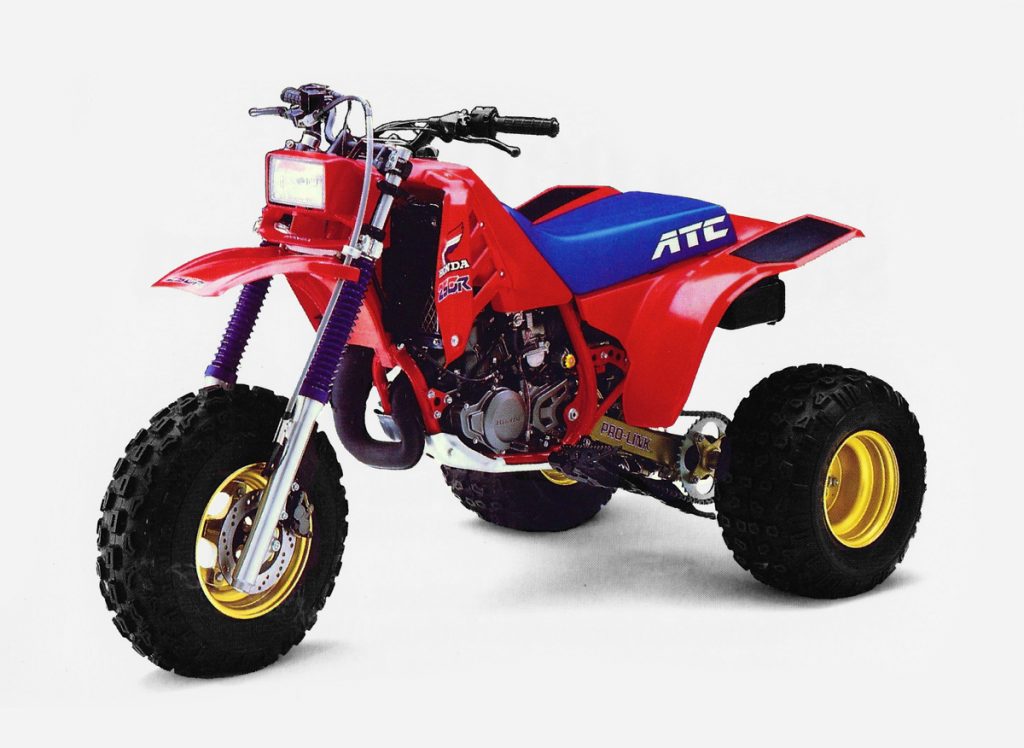 The 1986 season would be the last one in the U.S. for Honda’s incredibly successful ATC250R. After six years, three generations and countless sales, the original high-performance ATV would fall prey to political pressure and the inevitable march of technology. Photo Credit Honda
The 1986 season would be the last one in the U.S. for Honda’s incredibly successful ATC250R. After six years, three generations and countless sales, the original high-performance ATV would fall prey to political pressure and the inevitable march of technology. Photo Credit Honda
Today, the three-wheeled ATC (All Terrain Cycle) is something of a curiosity. To most people, it is a relic from an era when open face helmets were the norm and kids actually went outside to play after school. Once the most popular recreational off-road vehicle in the world, the ATC was more than a fad, it was a phenomenon. From its inception in 1970, until its final demise in 1988, Honda sold an astounding 6.5 million of these peculiar-looking machines. At a time when off-road riding was exploding in popularity, nothing was as hot as Honda’s balloon-tired little trike.
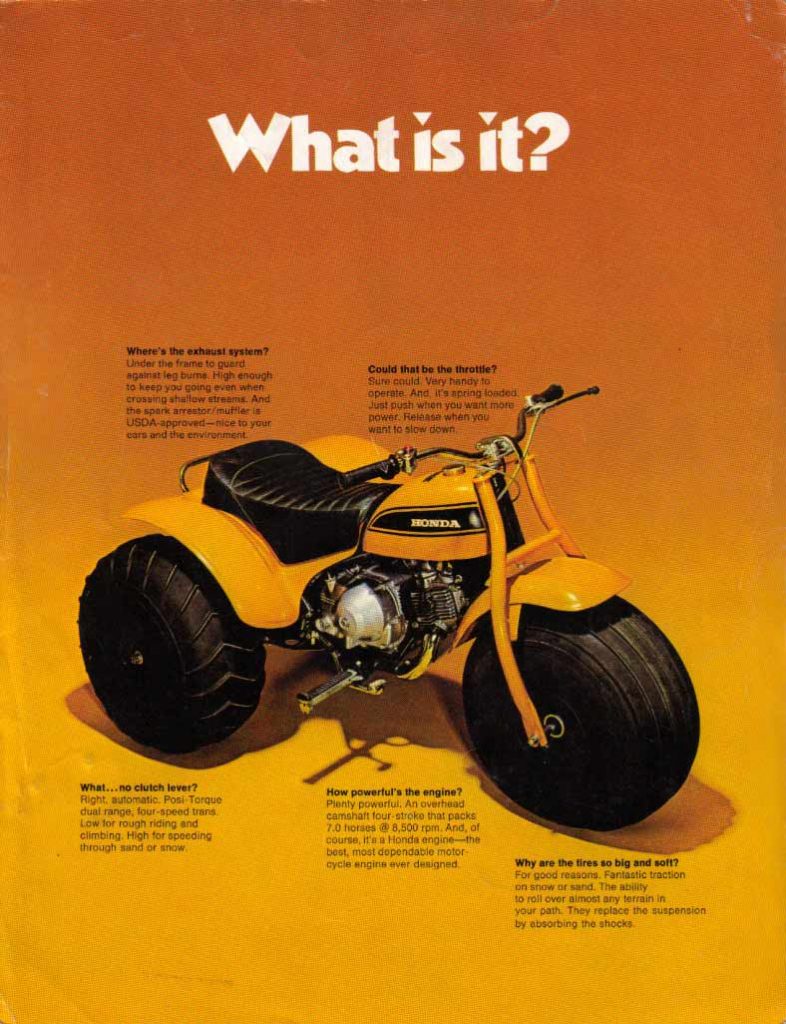 In 1970, Honda introduced the world to the first All Terrain Cycle. Originally designed to provide its dealers with a winter selling option, the US90 (later renamed ATC90) would give rise to a huge ATV market in America. Photo Credit Honda
In 1970, Honda introduced the world to the first All Terrain Cycle. Originally designed to provide its dealers with a winter selling option, the US90 (later renamed ATC90) would give rise to a huge ATV market in America. Photo Credit Honda
Introduced by Honda Motor Corporation in 1970, the original US90 (later renamed the ATC90 after Honda trademarked the “ATC” name) was the brainchild of Osamu Takeuchi. An engineer at Honda, Takeuchi had been tasked in 1967 with developing a product for dealers to sell in the slow winter months. In order to do this, Takeuchi and his team of engineers had explored all manner of two, three, four and even six-wheel configurations. At the time, six-wheeled all-terrain buggies were all the rage and Honda thought there might be a market for a smaller and more-maneuverable alternative.
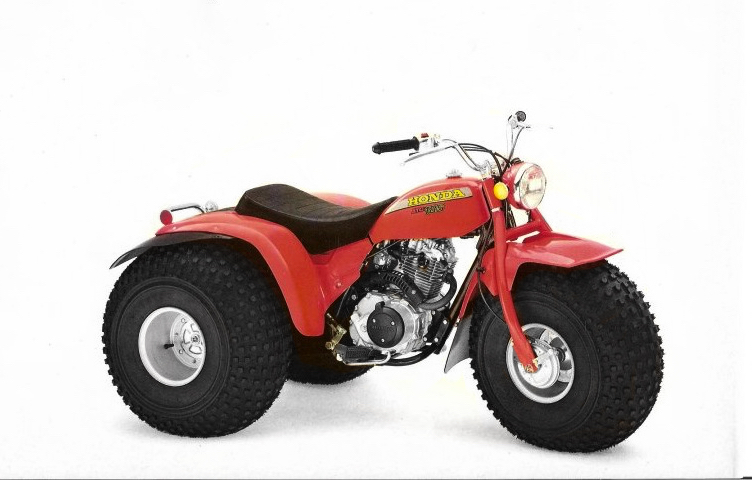 In 1980, Honda introduced its most powerful ATV yet, the ATC185. In spite of its modest four-stroke power and utter lack of suspension, the 185 actually found its way to race tracks as riders hungry for a performance ATC turned to the aftermarket to make one of their own. Photo Credit: Honda
In 1980, Honda introduced its most powerful ATV yet, the ATC185. In spite of its modest four-stroke power and utter lack of suspension, the 185 actually found its way to race tracks as riders hungry for a performance ATC turned to the aftermarket to make one of their own. Photo Credit: Honda
In the end, Takeuchi’s team settled on a three-wheeled configuration. This allowed the team to keep the all-terrain capability of a buggy (through the use of large high-floatation tires), while improving maneuverability and lowering cost. Using a SOHC four-stroke single sourced from their existing ST70 motorcycle, the new machine offered modest performance, but great versatility. It was great fun in the types of terrain that gave traditional motorcycles fits. Pumping out seven horsepower through its giant balloon tires and dual-range transmission, the ATC could handle snow, mud and sand with equal ease. As long as getting there fast was not a priority, the ATC90 was a capable companion.
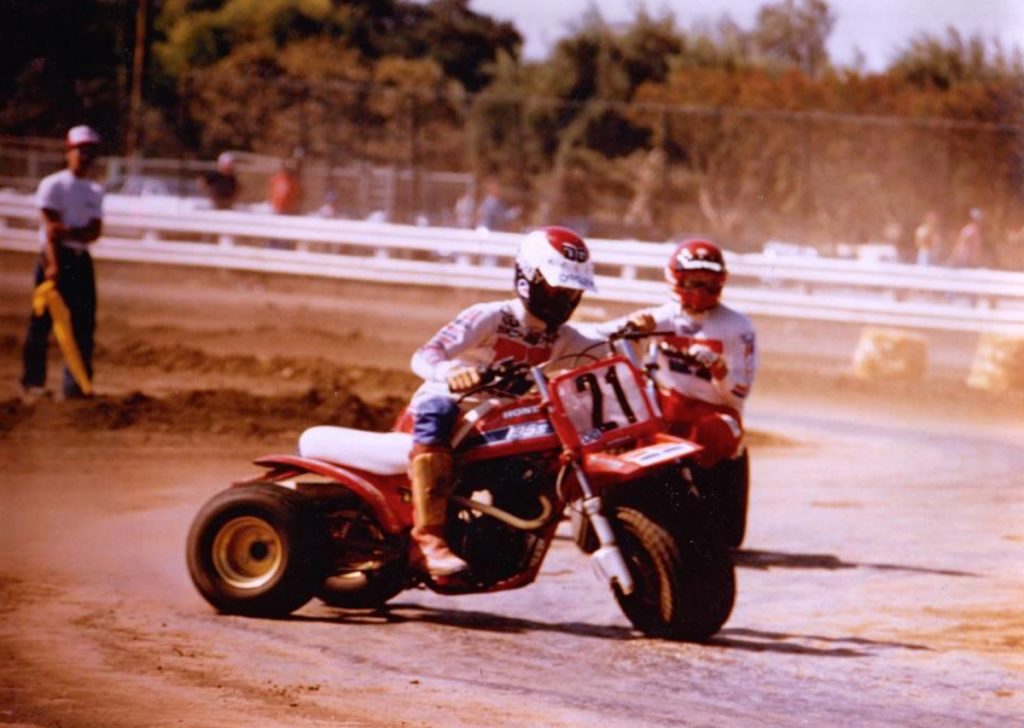 With the help of the aftermarket, Honda’s mild-mannered ATC185 could actually be turned into a pretty formidable racer. Power upgrade packages easily doubled the 185’s meager output and full frame kits added suspension front and rear. Photo credit: Unknown
With the help of the aftermarket, Honda’s mild-mannered ATC185 could actually be turned into a pretty formidable racer. Power upgrade packages easily doubled the 185’s meager output and full frame kits added suspension front and rear. Photo credit: Unknown
Once consumers got a look at this odd new contraption, they began flying off the showroom floors. At $595, the ATC offered an affordable way to go exploring off-road. With its Swivel-Lok™ (bars designed to fold up to aid transport) handle bars and compact size, the ATC could be carried in the trunk of a full-size car or station wagon. It was also less intimidating than a traditional motorcycle, appearing (at least initially) to be no harder to handle than a lawn tractor. Dads, moms, farmers and dune riders took to the ATC like bees to honey and snapped up the machines in droves.
 In 1981, Honda officially entered the high-performance ATV market with their first purpose-built racing three-wheeler, the ATC250R. With full suspension front and rear, a front disc brake and a powerful CR-based two-stroke motor, the new 250R offered performance never before dreamed of in a stock ATV. Photo Credit: Honda
In 1981, Honda officially entered the high-performance ATV market with their first purpose-built racing three-wheeler, the ATC250R. With full suspension front and rear, a front disc brake and a powerful CR-based two-stroke motor, the new 250R offered performance never before dreamed of in a stock ATV. Photo Credit: Honda
In 1973, Honda added a 70cc version for the kiddies and over the next few years, refined their full-size ATC package. Steel hubs made their debut in 1975 (early ATCs used a hubless design that made tire repairs a nightmare) and better tires made punctures less likely. In 1979, they finally bumped up the performance with a new 105cc motor for the full-size ATC. Rebadged the ATC110, this new trike offered more torque and an enclosed drive for better durability, but still no suspension (aside from the bounce of its balloon tires).
 Once the new 250R hit the market, ATV racing really took off in America. The new ATC was raced from coast to coast in desert, cross-country, TT and motocross events. Photo Credit: Dean Kirsten
Once the new 250R hit the market, ATV racing really took off in America. The new ATC was raced from coast to coast in desert, cross-country, TT and motocross events. Photo Credit: Dean Kirsten
For ATC enthusiasts, 1980 is where things finally started to get interesting. After a decade of puttering around camp sites and corn fields, Honda decided it was time to inject a little performance into their ATC line. A new model, the ATC185, doubled the power of the 110 and added larger 25-inch tires and a five-speed gearbox. The motor was loosely based on the (relatively) high-performance XR line and the chassis featured heavy-duty tube construction like a traditional motorcycle. There was still no suspension, but the 185 offered by far the most performance ever seen in an ATC.
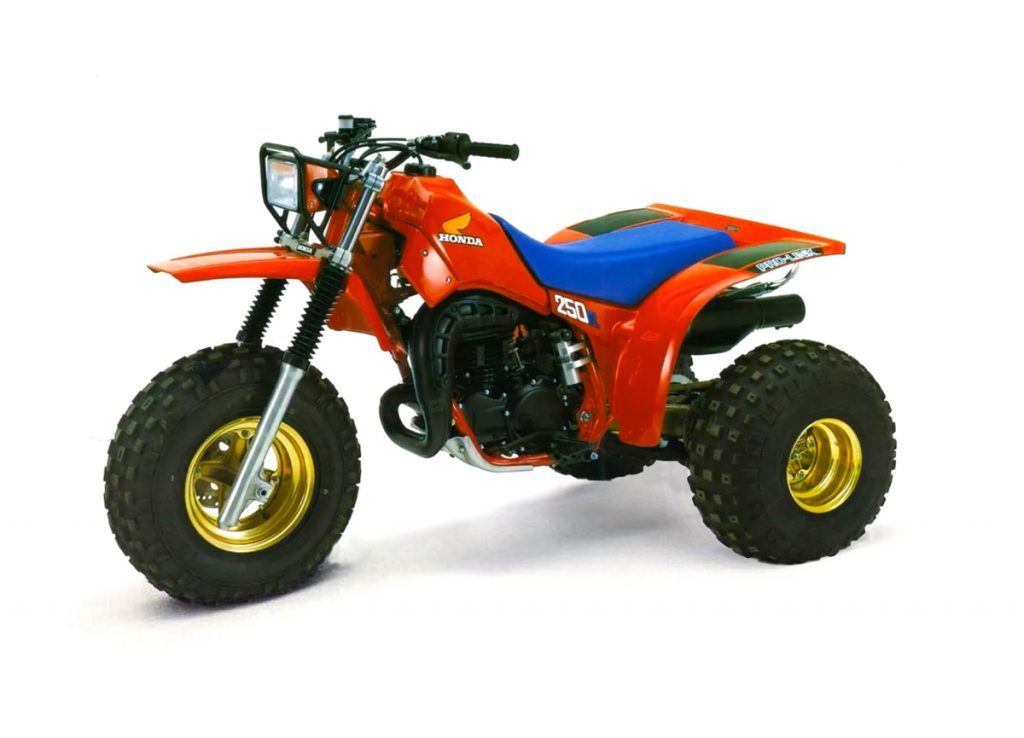 In 1983, Honda introduced the second generation of their ATC250R. Modest improvments in motor performance were overshadowed by major gains in handling and suspension. Photo Credit: Honda
In 1983, Honda introduced the second generation of their ATC250R. Modest improvments in motor performance were overshadowed by major gains in handling and suspension. Photo Credit: Honda
Once customers got their hands on the 185, some of them got the crazy idea to actually start racing them. Because the motor was based off of the XR line, it could be easily upgraded to produce more than double the stock power. The new chassis was also far easier to modify than previous ATCs, due to its use of a motorcycle-style tube design with a full engine cradle. Within no time, aftermarket companies began offering engine and suspension kits for the 185 that turned it from a “cow-trailer” into a legitimate racer.
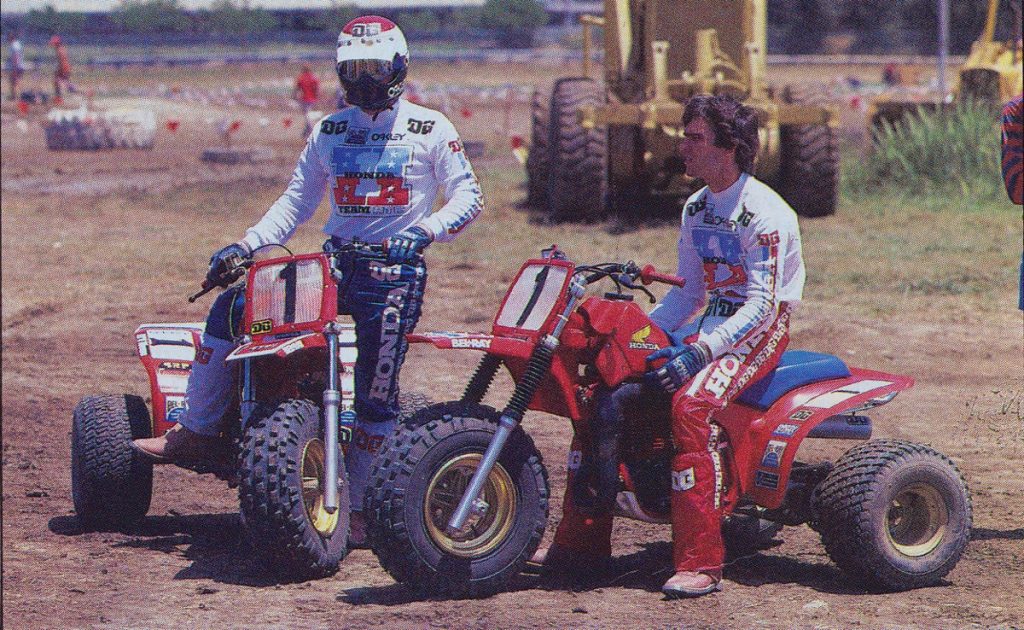 In the early eighties, ATC racing was big business for Honda. They fielded powerful race teams led by stars like Dean Sundahl (left) and Mike Coe (right). Photo Credit: 3 Wheelin
In the early eighties, ATC racing was big business for Honda. They fielded powerful race teams led by stars like Dean Sundahl (left) and Mike Coe (right). Photo Credit: 3 Wheelin
In 1981, this shift from toy, to “oh boy,” finally hit overdrive with the introduction of Honda’s third all-new ATC in as many years, the revolutionary new ATC250R. Using a high-performance two-stroke single for power and boasting full suspension front and rear (both firsts for Honda ATCs), the 250R was clearly aimed at a different customer than its previous three-wheelers. Loosely based off of their successful CR250R motor, the new 248cc power plant featured a manual clutch, kickstarting, a close-ratio five-speed transmission and a counterbalance to quell vibration. Although in a much milder state of tune than its CR cousin, the new 250R motor pumped out power far in excess of anything else ever seen on a stock ATV.
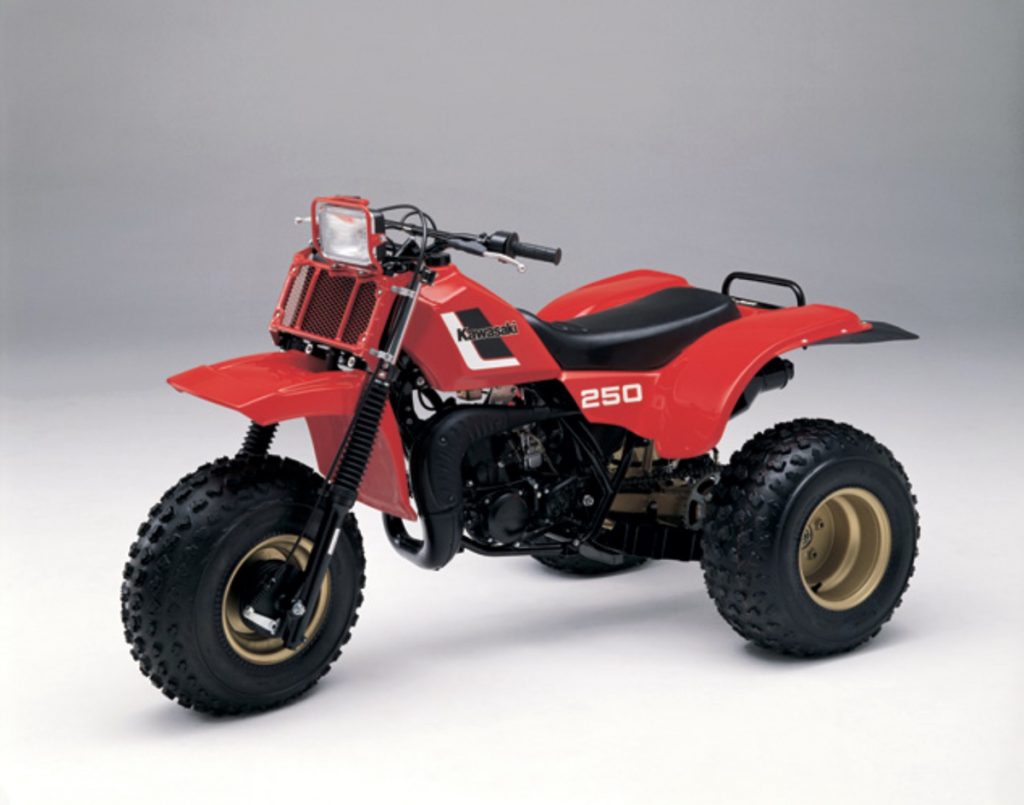 In 1984, the ATC250R received its first competition in the form of Kawasaki’s new KXT250 Tecate. Photo Credit: Kawasaki
In 1984, the ATC250R received its first competition in the form of Kawasaki’s new KXT250 Tecate. Photo Credit: Kawasaki
With 6.7 inches of travel in front and 4.3 inches out back, the new 250R was capable of traversing rough terrain at speeds unheard of on a stock ATC185 or ATC110. With its balloon tires and modest travel, there was still a lot of bounce on hard landings, but jumps were no longer completely out of the question. When it came time to slow things down, there was a hydraulic disc brake at the front (a feature even motocross bikes lacked in 1981) and a mechanical drum at the rear.
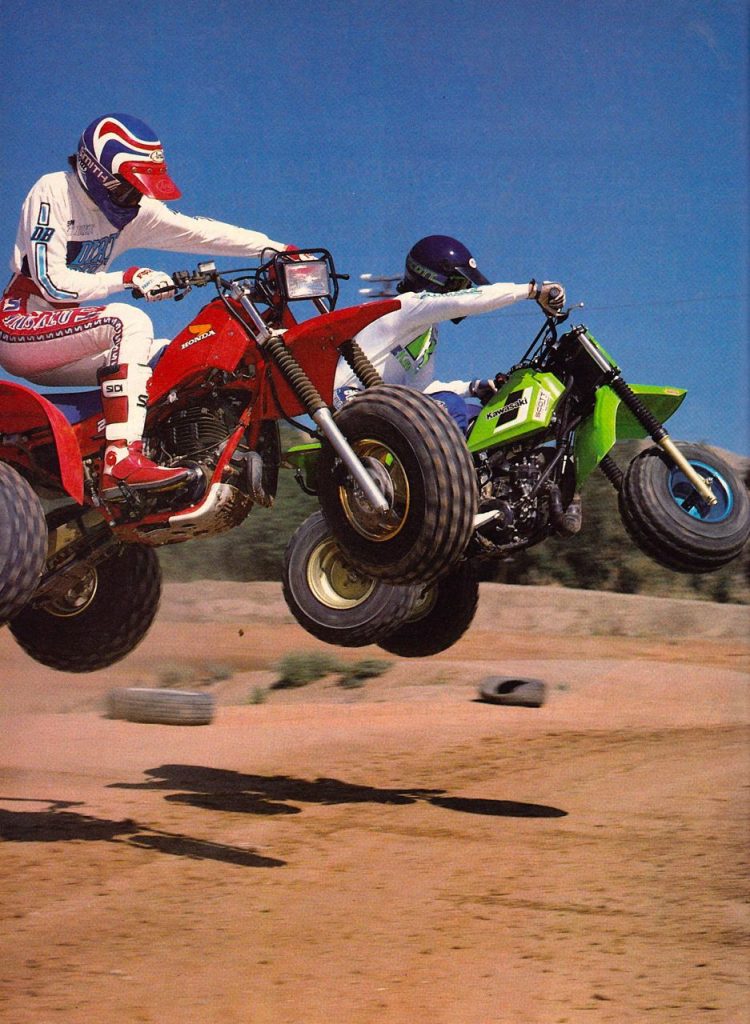 With its liquid-cooled KX-based motor, the new Tecate was able to outpower the 250R in 1984. Photo Credit: Dirt Bike
With its liquid-cooled KX-based motor, the new Tecate was able to outpower the 250R in 1984. Photo Credit: Dirt Bike
Quite predictably, the 250R turned out to be a huge hit with consumers. Now you could roll a new ATC off the showroom floor and go straight to the track with only minimal modifications. If you took off the lights, swapped out the tires and ditched the thumb throttle, you were pretty much good to go. Within no time, ATC250Rs were seen racing across the desert, sliding around TT tracks and roosting up sand drags in the dunes.
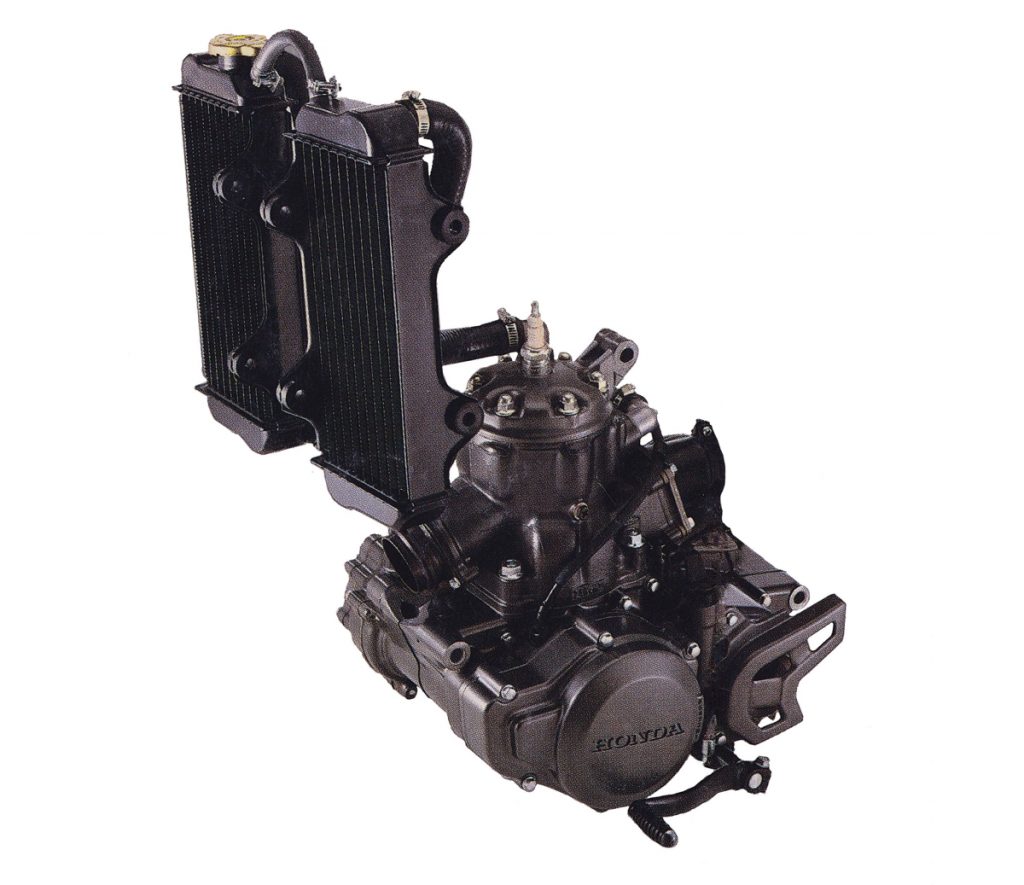 For 1985, Honda finally ditched its original air-cooled motor and dialed up an all-new liquid-cooled design. Even without the benefit of the CR250R’s ATAC system, the new 246cc six-speed mill pumped out an astonishing 42% more power than 1984. Photo Credit: Honda
For 1985, Honda finally ditched its original air-cooled motor and dialed up an all-new liquid-cooled design. Even without the benefit of the CR250R’s ATAC system, the new 246cc six-speed mill pumped out an astonishing 42% more power than 1984. Photo Credit: Honda
In 1983, Honda once again upped ATV ante by introducing a totally redesigned ATC250R. In many ways, this second-generation model showed the way forward for high-performance ATVs. Suspension travel was up appreciably both front and rear, with the new Pro-Link shock offering nearly double the travel of 1982. New lower-profile tires in the rear aided sliding and a new taller and narrower-profile front made turning more responsive. Powerful hydraulic disc brakes front and rear once again trumped the motocross line and a trick up-the-tank seat mimicked the saddles on Honda’s factory racers. The motor remained air-cooled, but a larger carb (30mm vs. 27mm), redesigned airbox and new pipe boosted output by two horsepower over ’82. On the chassis front, a redesigned frame increased rigidity and added two-and-a-half inches to the wheelbase (helping alleviate the wheelie problems of the original design). In spite of having nearly twice the suspension travel, the new machine only sat a half-inch taller than 1982.
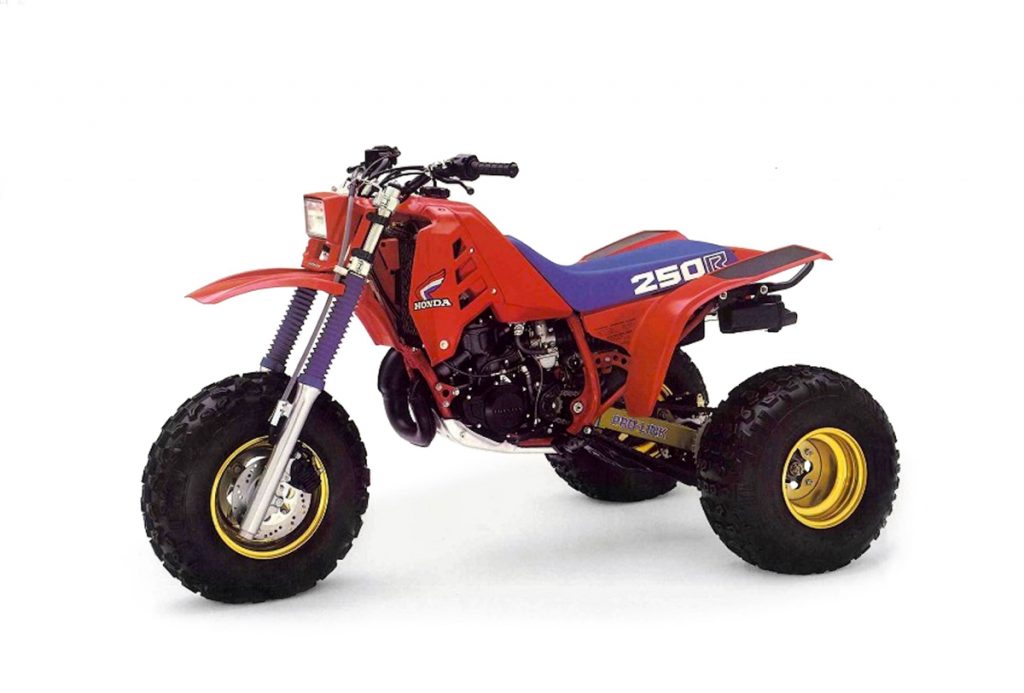 All-new from the ground up, the ’85 ATC250R featured major upgrades in every department. Photo Credit: Honda
All-new from the ground up, the ’85 ATC250R featured major upgrades in every department. Photo Credit: Honda
While the new machine was not hugely more powerful, it did prove exponentially faster on the track. The new narrow-profile front tire and improved geometry gave the R much more responsive turning and the less “balloony” rear tires made sliding much more predictable. The new large-diameter 38mm forks were a major step up from the puny CR80-derived units on the original. On the track, they soaked up hits that would have sent the previous model crashing to the stops. Out back, the new Pro-Link rear used technology from the motocross line to extend travel and lower the center of gravity. Overall, the ’83 model was not quite the revolution the ’81 had been, but it was a major step forward in ATV performance.
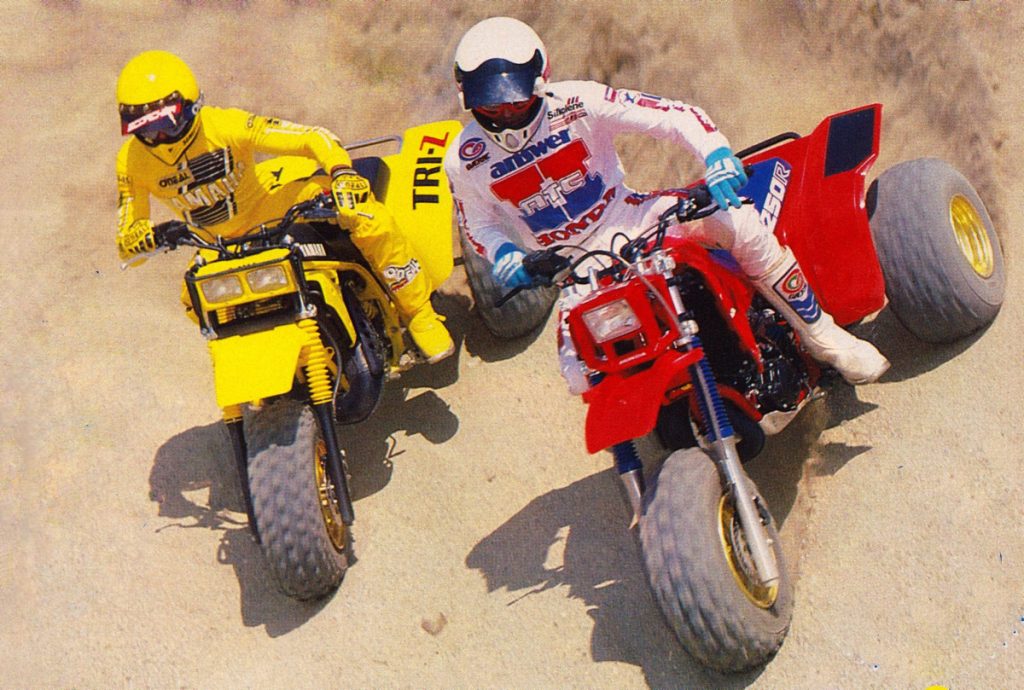 In 1985, Yamaha finally threw its hat into the ring with a high-performance three-wheeler of their own. The new Tri-Z 250 offered an innovative frame and layout, but lagged behind its competitors in outright performance. Photo Credit: 3 and 4 Wheel Action
In 1985, Yamaha finally threw its hat into the ring with a high-performance three-wheeler of their own. The new Tri-Z 250 offered an innovative frame and layout, but lagged behind its competitors in outright performance. Photo Credit: 3 and 4 Wheel Action
In 1984, the three-wheeled high-performance market finally received a little competition with introduction of Kawasaki’s KXT250 Tecate. Like the 250R, the new Tecate borrowed technology from its motocross brethren and came ready for battle with full suspension and a powerful two-stroke motor. There, the Tecate proved to have an advantage over the more refined Honda. Out of the hole, the Honda was competitive, but once into the midrange, the Kawasaki pulled ahead. On top end, it was no contest, as the green (or sometimes red) machine pulled away in a cloud of roost. With its larger-diameter wheels and low-profile tires, the Kawasaki slid more predictably and turned quicker. It also felt more like a motocross machine, with its stock twist throttle (the 250R continued to employ the same thumb-style throttle they had used since 1970) and rear-kicking starter.
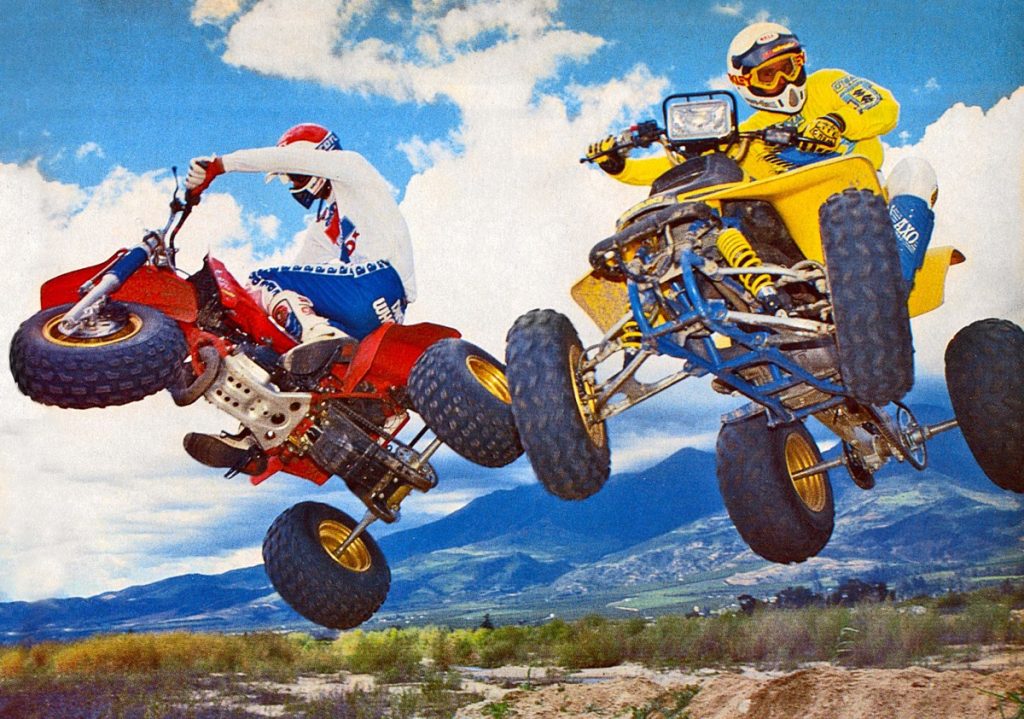 In 1985, by far the biggest challenge to the 250R’s supremacy was Suzuki’s all-new LT250R Quadracer. Even with its mellow dual-sport sourced motor and mediocre shocks, the Quadracer was the pick of most magazine shootouts due to its superior stability. Photo Credit: Dirt Wheels
In 1985, by far the biggest challenge to the 250R’s supremacy was Suzuki’s all-new LT250R Quadracer. Even with its mellow dual-sport sourced motor and mediocre shocks, the Quadracer was the pick of most magazine shootouts due to its superior stability. Photo Credit: Dirt Wheels
On the handling front, those lower tires helped make the Kawasaki less prone to two-wheeling and more predictable entering turns. The overall layout was longer, lower and wider than the Honda and big guys tended to be less cramped on the green machine. Where the Kawasaki suffered, however, was in the suspension and details department. There, the Honda pulled ahead with dual discs to the KXT’s drums, better suspension front and rear and a much more refined package. Plastic quality and fitment were far better on the Honda and its motor provided far less vibration than the non-counterbalanced Kawasaki.
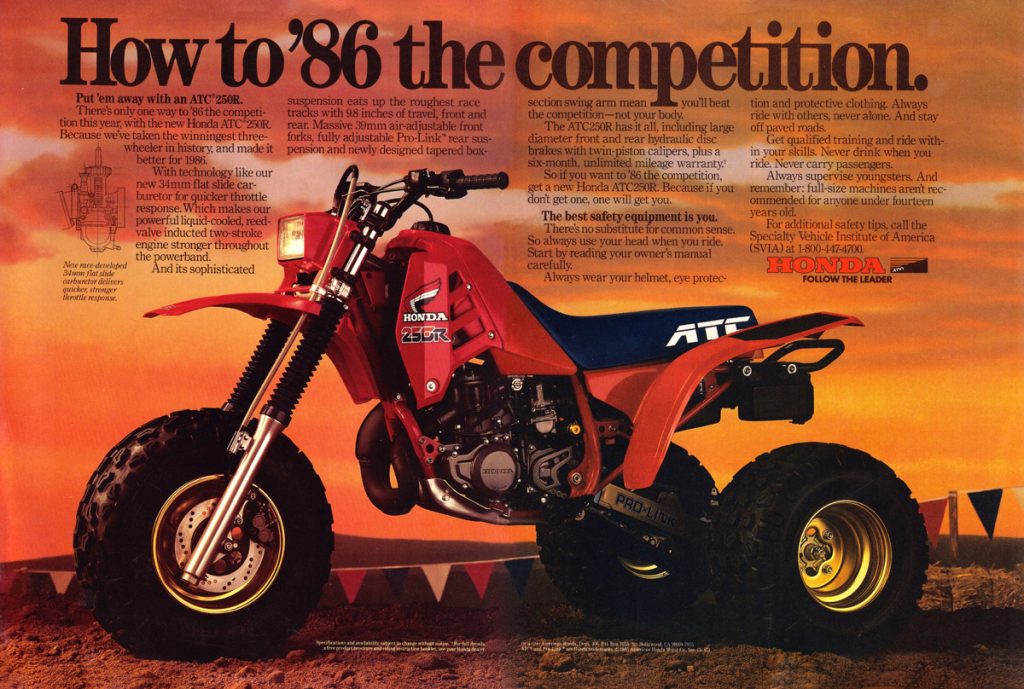 For 1986, Honda chose to stick with minor refinements to their winning 250R package. Photo Credit: Honda
For 1986, Honda chose to stick with minor refinements to their winning 250R package. Photo Credit: Honda
For 1985, Honda knew they would have to up their game to stay competitive in the now hotly-contested ATV performance sweepstakes. In edition to an improved KXT250, Honda would now be facing competition from both Yamaha and Suzuki. The new Tri-Z 250 stole from the existing three-wheeler playbook and offered a 246cc liquid-cooled two-stroke motor and long-travel suspension.
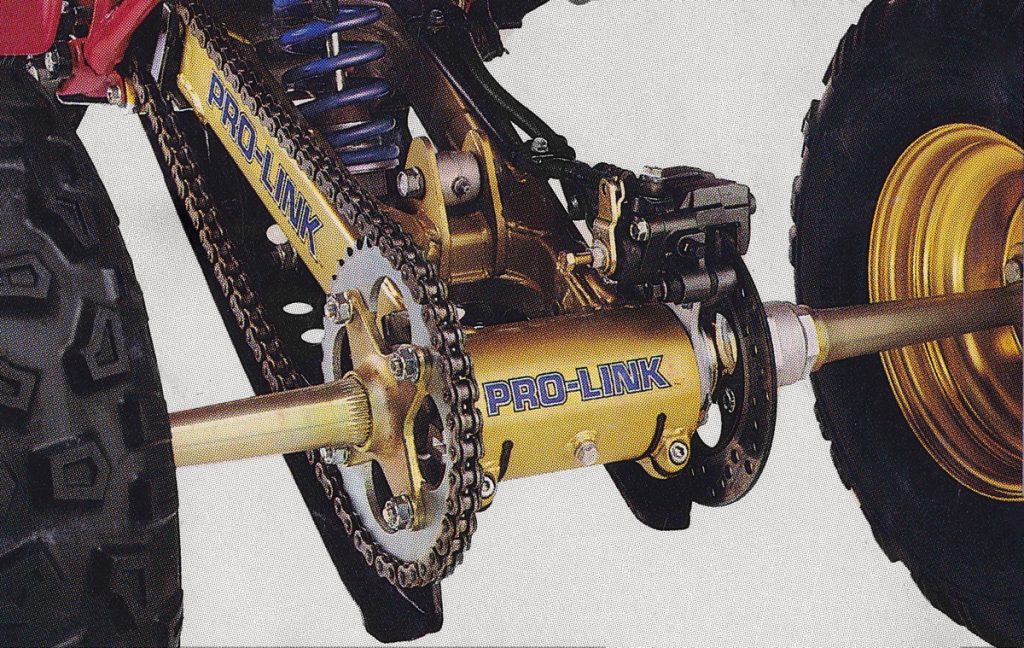 An all-new tapered box-section swingarm for 1986 extended the wheelbase by .4 inches. Photo Credit: Honda
An all-new tapered box-section swingarm for 1986 extended the wheelbase by .4 inches. Photo Credit: Honda
In the Suzuki camp, things looked quite a bit different with the introduction of a whole new type of high-performance ATV. Dubbed the “Quadracer”, this new machine kept the powerful two-stroke motor of the others, but bolted it to an all-new four-wheeled chassis. This gave the Suzuki major advantages in cornering and stability over its three-wheeled competitors.
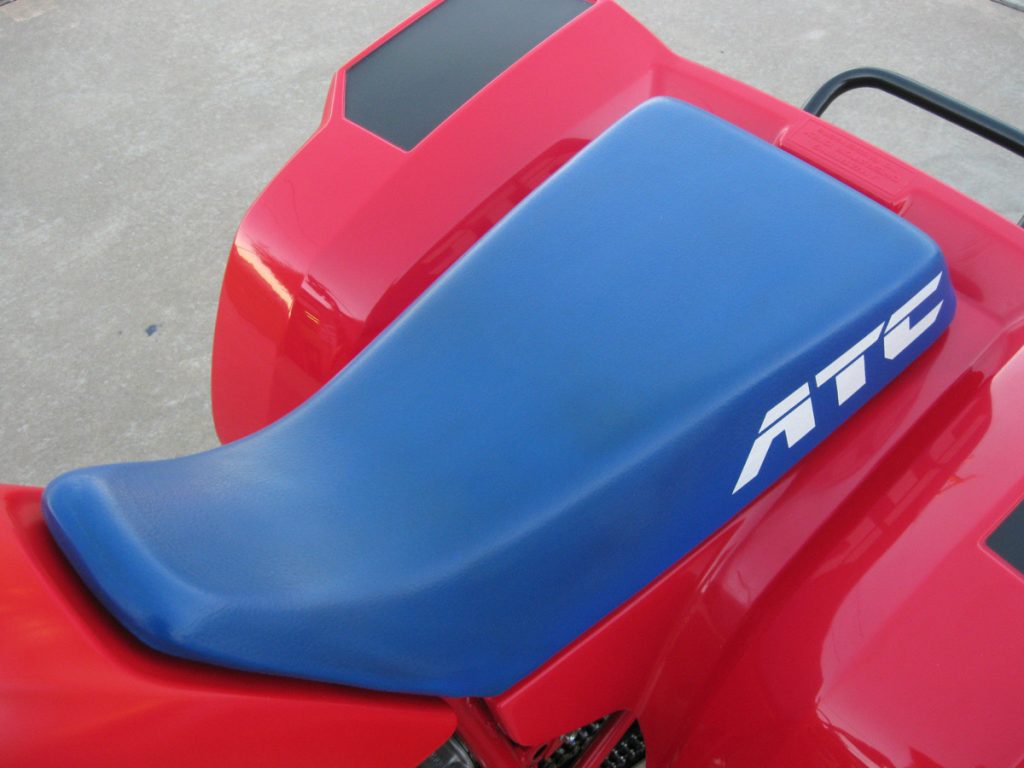 A new saddle for 1986 raised seat height by .6-inches to aid rider movement and increase comfort.
A new saddle for 1986 raised seat height by .6-inches to aid rider movement and increase comfort.
In order to keep up with the ever-stiffening competition, Honda dialed up a totally redesigned ATC250R for 1985. The new machine was longer, wider and more capable than ever. A new motor was spec’d that finally added water-cooling and an additional gear was stuffed into the transmission to aid versatility. With new porting, a redesigned exhaust, a larger carb (34mm) and liquid cooling, Honda’s engineers were able to squeeze out a whopping 42% increase in power over 1984. Even though it was an all-new design, Honda chose to not give the 250R the CR’s ATAC Power Valve system. This helped keep costs down and simplified overall maintenance.
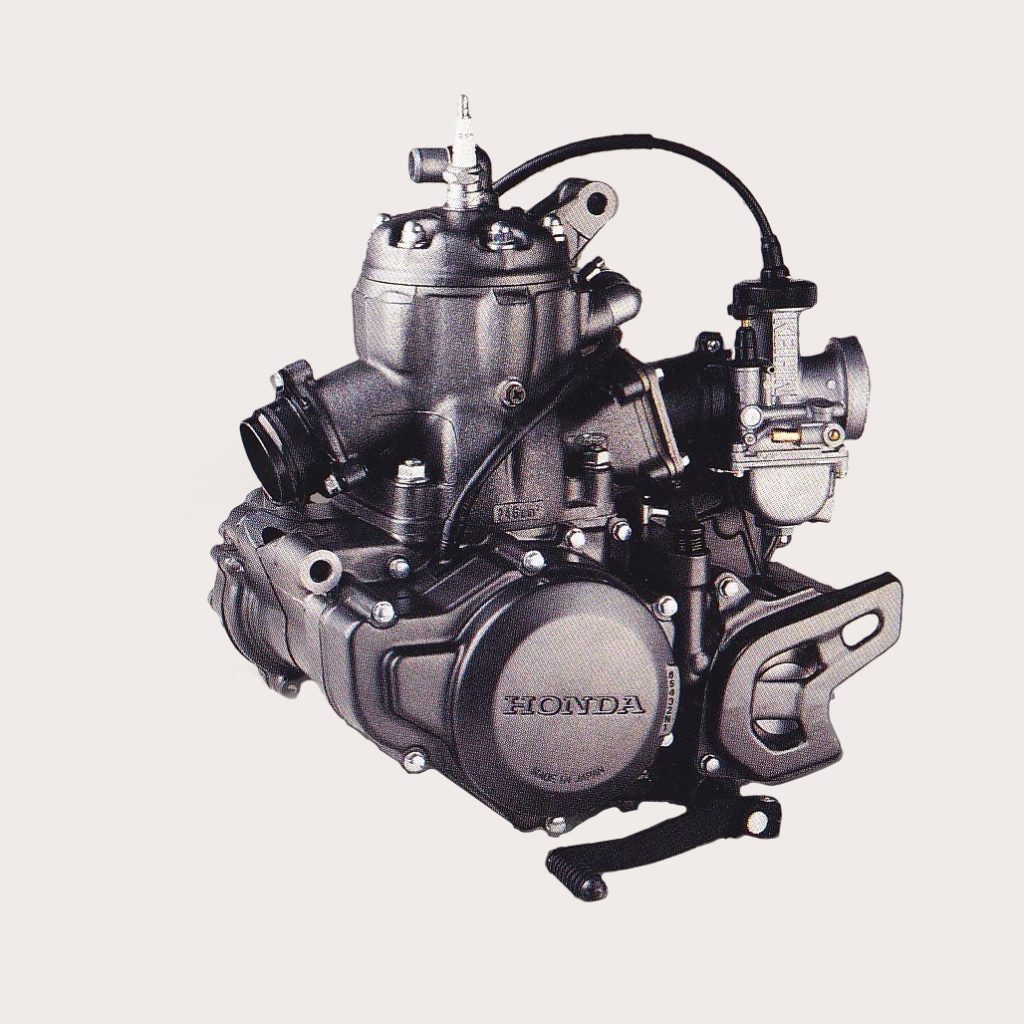 A new coat of “Dark Shot Silver” paint and the addition of a 34mm Keihin “flat-slide” carburetor were the only significant changes to the 250R’s six-speed power plant for 1986.
A new coat of “Dark Shot Silver” paint and the addition of a 34mm Keihin “flat-slide” carburetor were the only significant changes to the 250R’s six-speed power plant for 1986.
On the suspension front, the new 250R boasted a full two inches of additional travel front and rear. The new Showa shock offered 17 adjustments on compression and 12 on rebound. With its new Pro-Link linkage, it offered 9.8 inches of plush travel. Up front, new 39mm (up 4mm from 1984) trailing-axle Showa forks offered air-adjustability and 9.8 inches of movement.
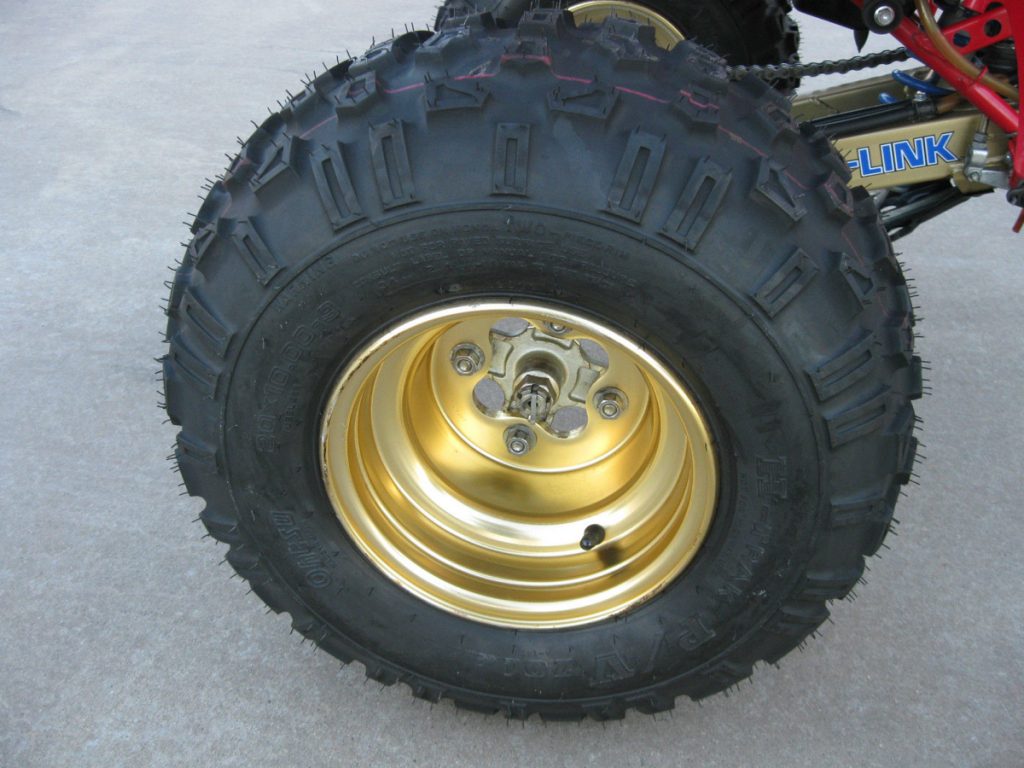 An upgrade to a larger 9” wheel and low-profile tires in ’85 greatly aided the handling performance of the ATC250R. For 1986, a switch from Dunlop to Ohtsu for the tire supplier further refined performance by reducing sidewall flex for more-stable cornering.
An upgrade to a larger 9” wheel and low-profile tires in ’85 greatly aided the handling performance of the ATC250R. For 1986, a switch from Dunlop to Ohtsu for the tire supplier further refined performance by reducing sidewall flex for more-stable cornering.
Along with its new frame, motor, and suspension, Honda spec’d all-new bodywork for the ‘85 250R. A new plastic tank (previous models used metal tanks) reduced weight, lowered the center of gravity and incorporated dual radiators for the first time. Both the front and rear fenders were also restyled, with slimmer profiles and a much more CR-like appearance. The plush safety saddle remained with a spiffy new 250R logo emblazoned on the side and a set of matching blue fork boots replaced the black of ’84.
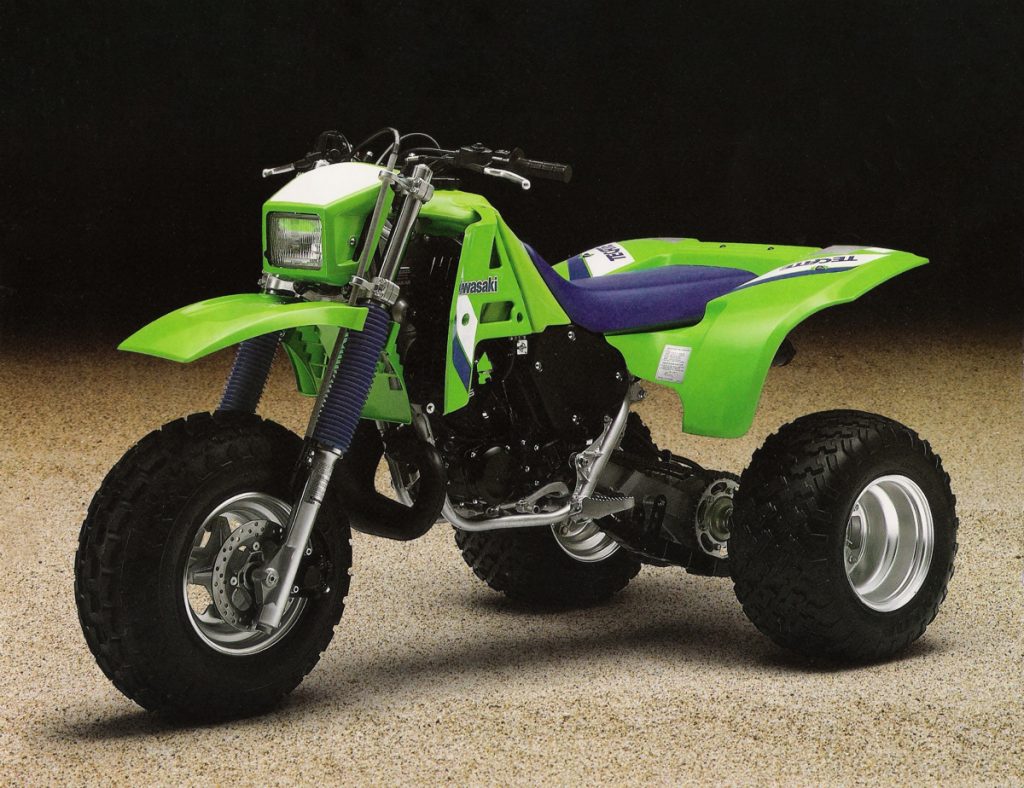 An all-new Tecate for 1986 upped the stakes in the performance three-wheeler wars. With its powerful KX-bred motor, racy stance and super-low-profile tires, the KXT250 was once again Honda’s biggest competitor for trike supremacy. Photo Credit: Kawasaki
An all-new Tecate for 1986 upped the stakes in the performance three-wheeler wars. With its powerful KX-bred motor, racy stance and super-low-profile tires, the KXT250 was once again Honda’s biggest competitor for trike supremacy. Photo Credit: Kawasaki
On the track and trail, the new 250R proved a quantum leap forward in performance. With an additional ten horsepower, the new machine had no trouble dusting off any of its predecessors and reclaiming the top spot in the ATV power wars. It was strong off the bottom, barky in the middle and satisfactory on top. If you kept it pinned, it would taper off after the strong midrange hit, but not completely fall off a cliff.
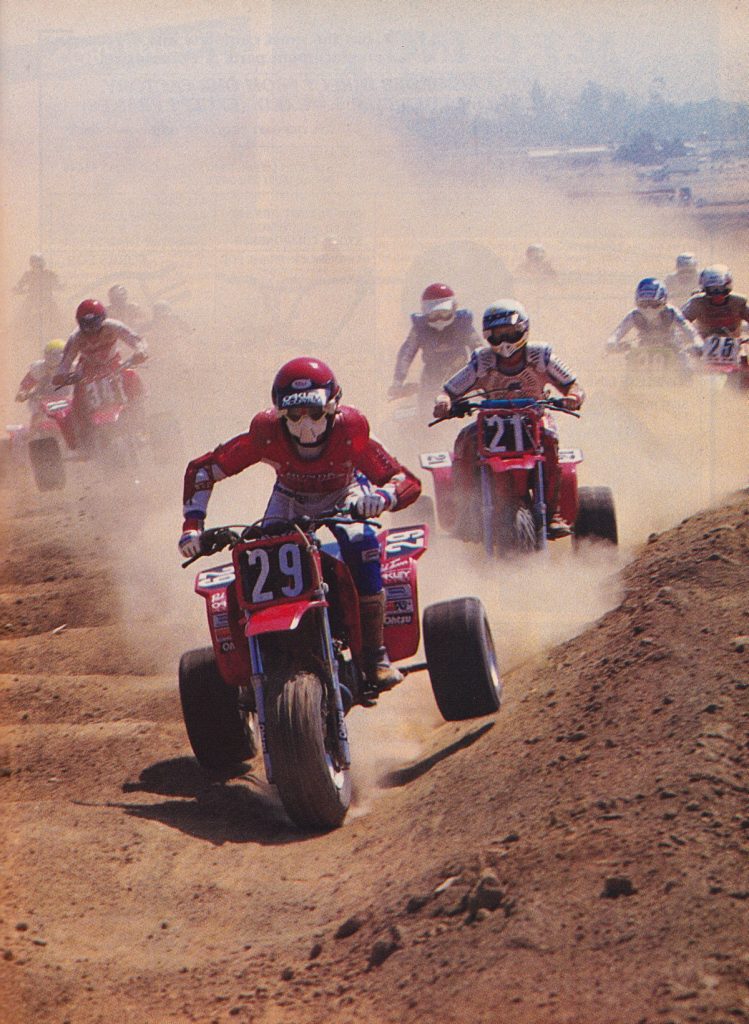 In 1986, ATC racing was still alive and well in America, but the winds of change were blowing… Photo Credit: Dirt Wheels
In 1986, ATC racing was still alive and well in America, but the winds of change were blowing… Photo Credit: Dirt Wheels
Compared to the previous class-leading Kawasaki, the Honda was far stronger off idle and brawnier through the middle, but not as potent on top. The 250R also vibrated a ton less (no counterbalancer in the KXT), shifted better and had a more durable clutch. For racing, the Kawasaki was still a viable option, but for trail work and general play riding the Honda was a far better choice.
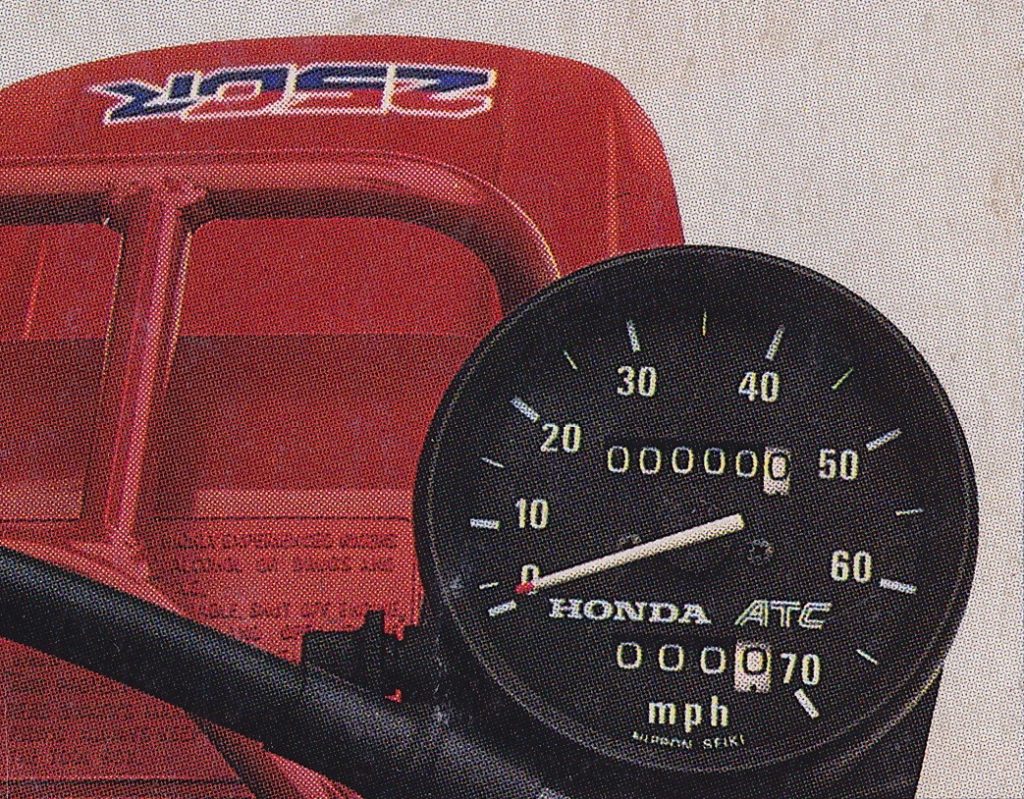 In 1986, Honda offered a huge variety of accessories for the 250R. Photo Credit: Honda
In 1986, Honda offered a huge variety of accessories for the 250R. Photo Credit: Honda
On the suspension front, the new ATC once again dominated the standings with the most travel and best damping performance in the class. While it lacked the stability advantage of the new Quadracer, its large 39mm forks made up for it with plush action that surpassed the new Suzuki’s shocks in the rough. Out back, the Pro-Link delivered a smooth ride that excelled at trail and light track work with equal aplomb.
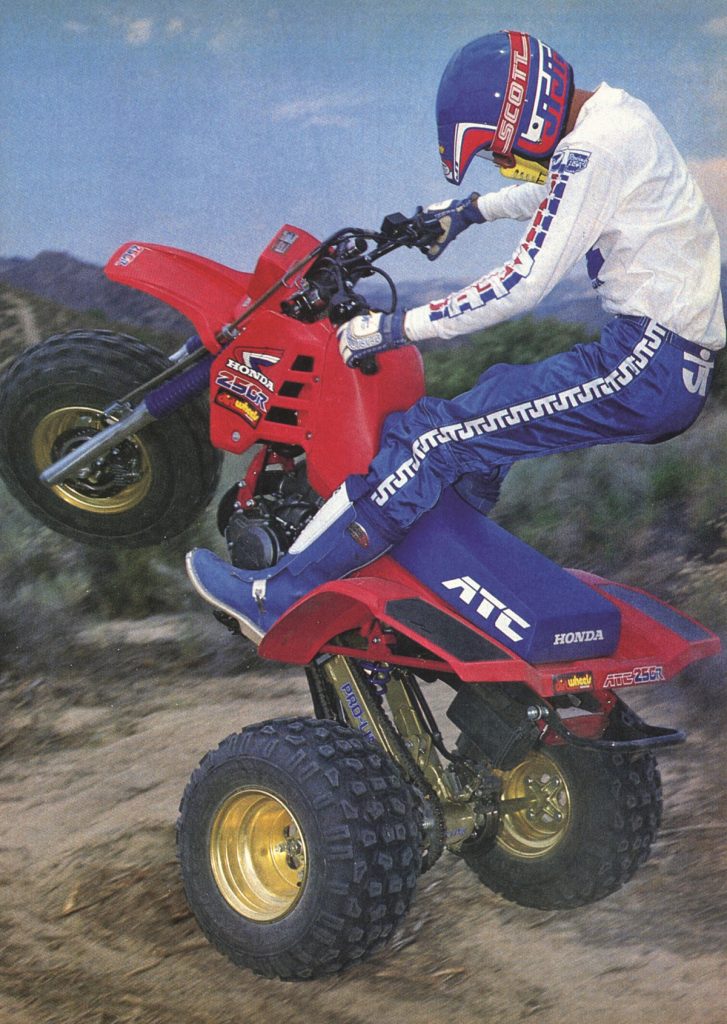 With excellent suspension front and rear, aerial maneuvers were a joy on the ’86 ATC250R. Photo Credit: Dirt Wheels
With excellent suspension front and rear, aerial maneuvers were a joy on the ’86 ATC250R. Photo Credit: Dirt Wheels
In the final ATV standings of ’85, the ATC250R dominated the motor, suspension, braking and refinement categories, but still lost out to the new Suzuki quad. In spite of being pretty slow and mediocrely suspended, the extra wheel advantage was too much for the 250R to overcome. The Quadracer may not have been as fast, but it was exponentially easier to ride and a definite nail in the coffin of the long-dominant ATC.
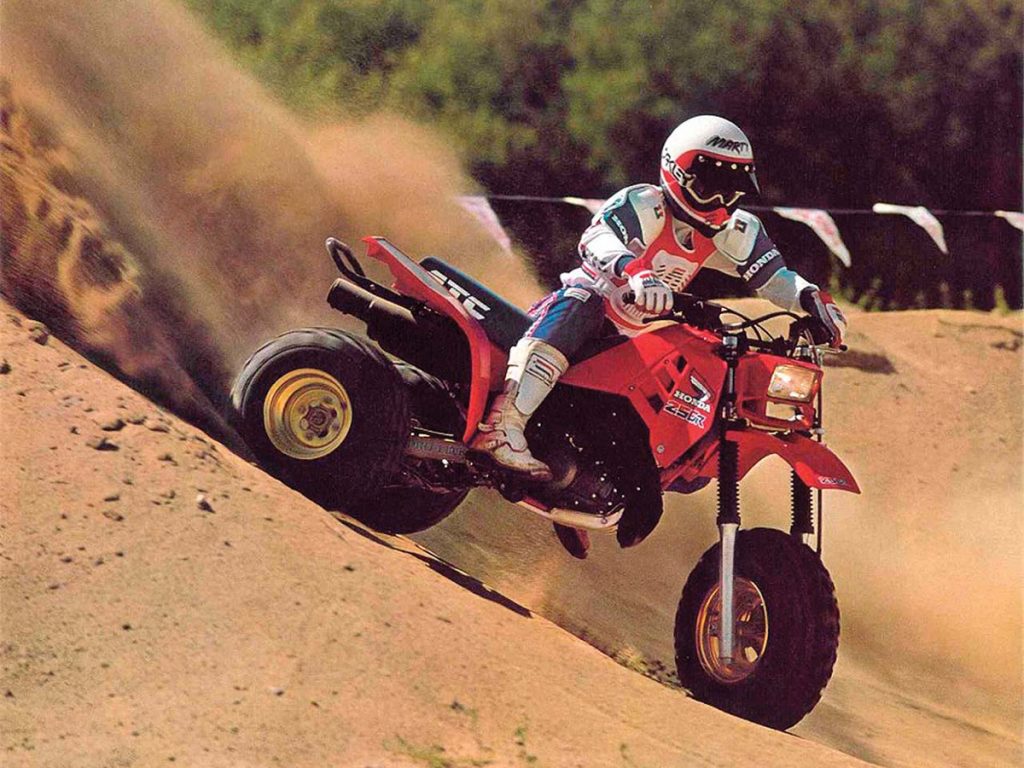 With handling that evenly split the difference between the long and slow turning Tri-Z and the twitchy motocross-bred Tecate, the 250R was the jack-of-all-trades in 1986. Here, factory Honda ATC pilot Marty Hart demonstrates that the ATC250R was more than capable of changing direction under the hands of a skilled rider. Photo Credit: Honda
With handling that evenly split the difference between the long and slow turning Tri-Z and the twitchy motocross-bred Tecate, the 250R was the jack-of-all-trades in 1986. Here, factory Honda ATC pilot Marty Hart demonstrates that the ATC250R was more than capable of changing direction under the hands of a skilled rider. Photo Credit: Honda
By 1986, it was becoming clear that the writing was on the wall for three-wheeled ATVs. The arrival of Suzuki’s LT125D Quadrunner in 1982 and success of the LT250R Quadracer in 1985 were already pointing the way forward for the future of ATV sales. In edition to these market forces, pressure from the mainstream media (who had demonized three-wheelers on high-profile outlets like 60 Minutes) and federal government were quickly making ATC sales less viable.
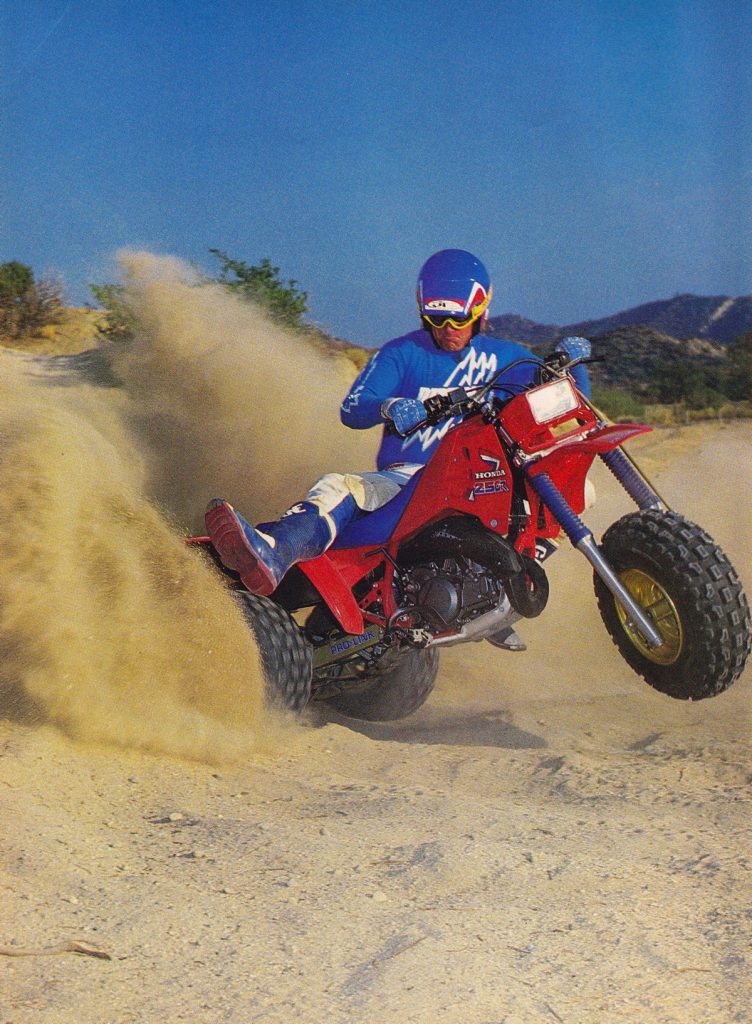 With a solid low-end and potent midrange, the 250R was more than capable of taking on all other comers in the 250 ATV division. Only the Kawasaki, with its advanced power valve motor, was able to out-power the Honda in 1986. Here Tom “Wolfman” Webb demonstrates the Honda’s potent burst. Photo Credit: Dirt Bike
With a solid low-end and potent midrange, the 250R was more than capable of taking on all other comers in the 250 ATV division. Only the Kawasaki, with its advanced power valve motor, was able to out-power the Honda in 1986. Here Tom “Wolfman” Webb demonstrates the Honda’s potent burst. Photo Credit: Dirt Bike
Seeing this market shift on the horizon, Honda was ready in 1986 with a full lineup of quads of their own. The new Fourtrax 350 4×4 built off of their successful Big Red line of utility ATVs and incorporated 4WD capability in an ATV for the first time. There was also an entry-level 70 and 125, as well as a sporty 200SX and farm-ready 250. Finally, there was a high-performance four-wheeled version the ATC250R set to take on Suzuki’s Quadracer at its own game.
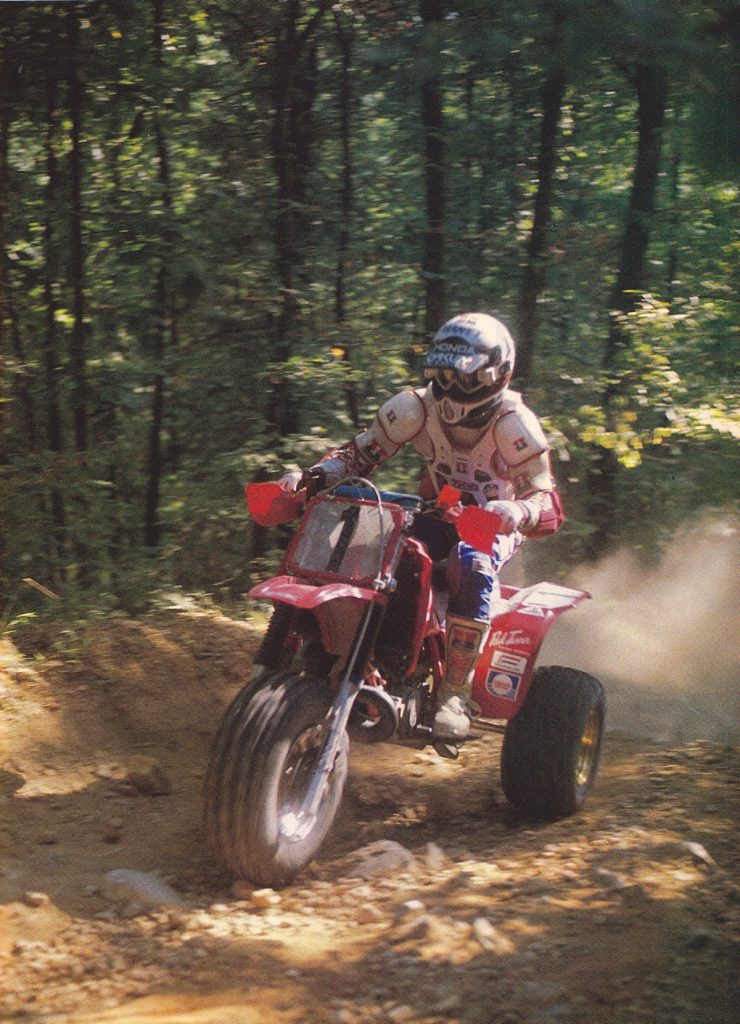 With its broad power and supple suspension, the 250R made a much better woods racer than Kawasaki’s high-strung Tecate. Here Honda Factory rider Marty Hart shows the ATC’s versatility by racing it in the 1986 Loretta Lynn’s Dirt Days AATVA cross country event. Photo Credit: Dirt Wheels
With its broad power and supple suspension, the 250R made a much better woods racer than Kawasaki’s high-strung Tecate. Here Honda Factory rider Marty Hart shows the ATC’s versatility by racing it in the 1986 Loretta Lynn’s Dirt Days AATVA cross country event. Photo Credit: Dirt Wheels
With this shift toward quads in full swing, Honda entered 1986 at a bit of a crossroads. An all-new 250R in 1985 showed their commitment to the ATC market, but long-term prospects for three-wheeled ATVs were starting to look pretty grim. The Consumer Product Safety Commission (CPSC) was already well on their way to making them the pariah of the off-road market and consumer preference was quickly shifting to the easier-to-manage quads.
With all these factors in mind, Honda set about making the 1986 ATC250R the final, and best ATC ever. Since the 250R was all-new in ’85, the Honda design team stuck to refinements for 1986. A new taller seat was bolted on to aid rider movement and new bars were added to improve comfort. The swingarm was lengthened slightly and head angle was altered .5 degrees. These two factors added up to a .4-inch increase in wheelbase for ’86. The new swingarm also offered a redesigned chain-adjustment system to simplify maintenance and a 1.5-inch wider axle to improve stability. Finally, a switch from Dunlop to Ohtsu tires for ’86 looked to improve handling and durability.
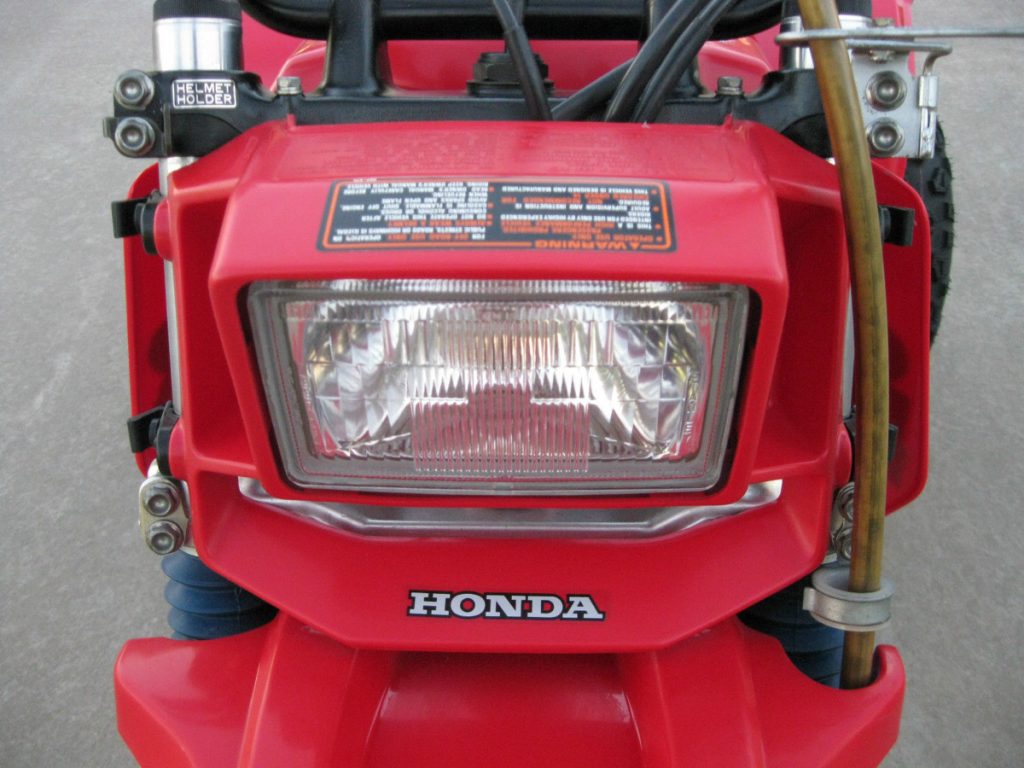 For competitive riding, the 250R’s attractive and useful headlight could be quickly removed by detaching four rubber clamps.
For competitive riding, the 250R’s attractive and useful headlight could be quickly removed by detaching four rubber clamps.
On the suspension end, the ’85 250R’s 39mm trailing-axle Showa forks were retained, but new single-rate springs were installed to allow for slightly more oil capacity. In the Pro-Link rear, the 250R continued to use a Showa shock that produced 9.8-inches of travel. As in 1985, there were adjustments for both compression and rebound damping available.
On the motor front, the 250R continued to do without any sort of power valve mechanism and carried over mostly unchanged from ’85. Aside from a color swap from black to “Dark Shot Silver,” the biggest motor change for ’86 was the switch to a 34mm “flat slide” Keihin carburetor from the round-slide of ‘85. This was done more to improve throttle response than actually increase outright power.
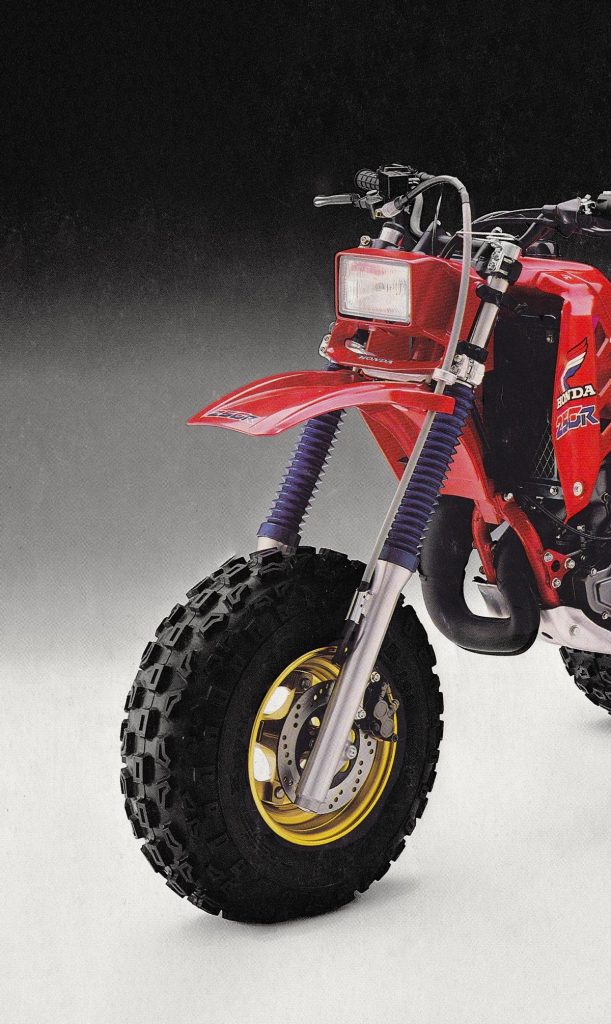 With 9.8-inches of plush travel, the 250R’s 39mm trailing-axle Showa forks afforded the best ride in the class. Photo Credit: Honda
With 9.8-inches of plush travel, the 250R’s 39mm trailing-axle Showa forks afforded the best ride in the class. Photo Credit: Honda
In spite of its simplicity and lack of major updates, the 246cc mill used in the 250R continued to be the most versatile in the class. It offered the widest useable spread of power, the least vibration and best ability to transition from the track to the trail. Off-road, it could be lugged way down low like a four-stroke and on the track, a slip of the clutch was all that was needed to blast out of a tight turn and over the next obstacle. Low-to-mid power was the best in the class, but the all-new KIPS-equipped Kawasaki Tecate for ’86 once again out-powered it on top by a considerable margin.
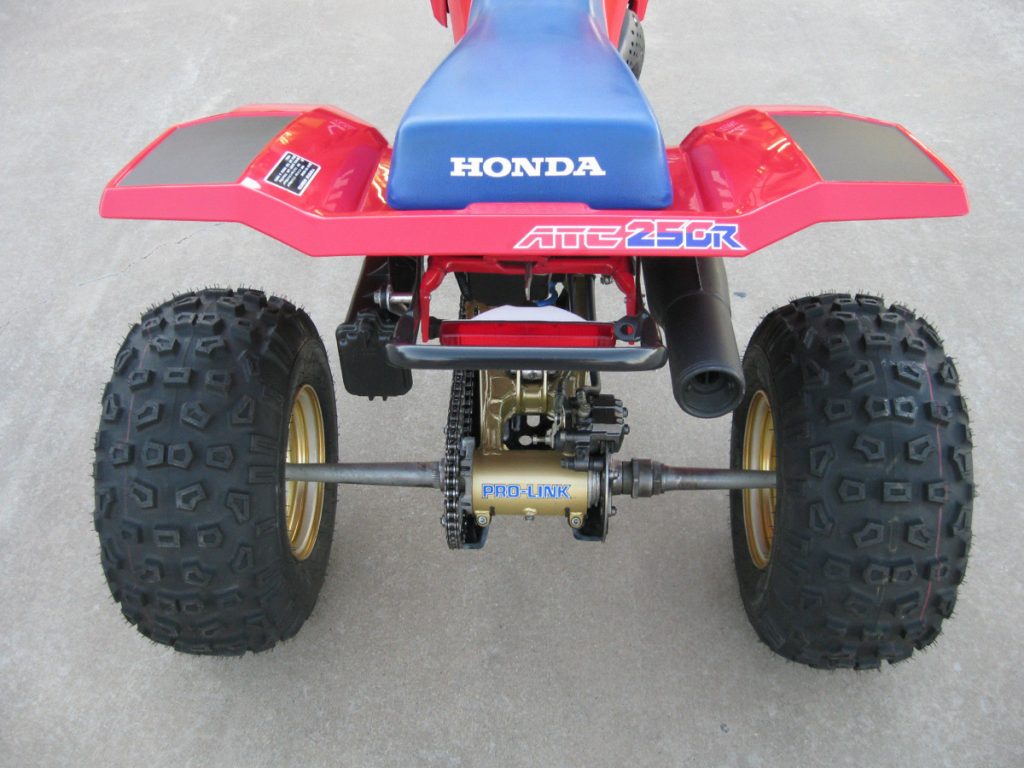 In the rear, the ATC250R once again offered 9.8-inches of travel to go with its adjustments for compression and rebound damping. While too soft for any serious motocross work, its Showa damper still offered the best combination of ride and control in the class.
In the rear, the ATC250R once again offered 9.8-inches of travel to go with its adjustments for compression and rebound damping. While too soft for any serious motocross work, its Showa damper still offered the best combination of ride and control in the class.
As in 1985, the Honda’s suspension proved the best in the class. Both the forks and shock outclassed the offerings on the Yamaha Tri-Z and Kawasaki Tecate. Plush and well-controlled, the ATC’s suspension did the best job of straddling trail comfort and track stiffness. Pro racers would of course need a major upgrade at both ends, but for the kind of mixed use most 250Rs would enjoy, it was excellent for the time.
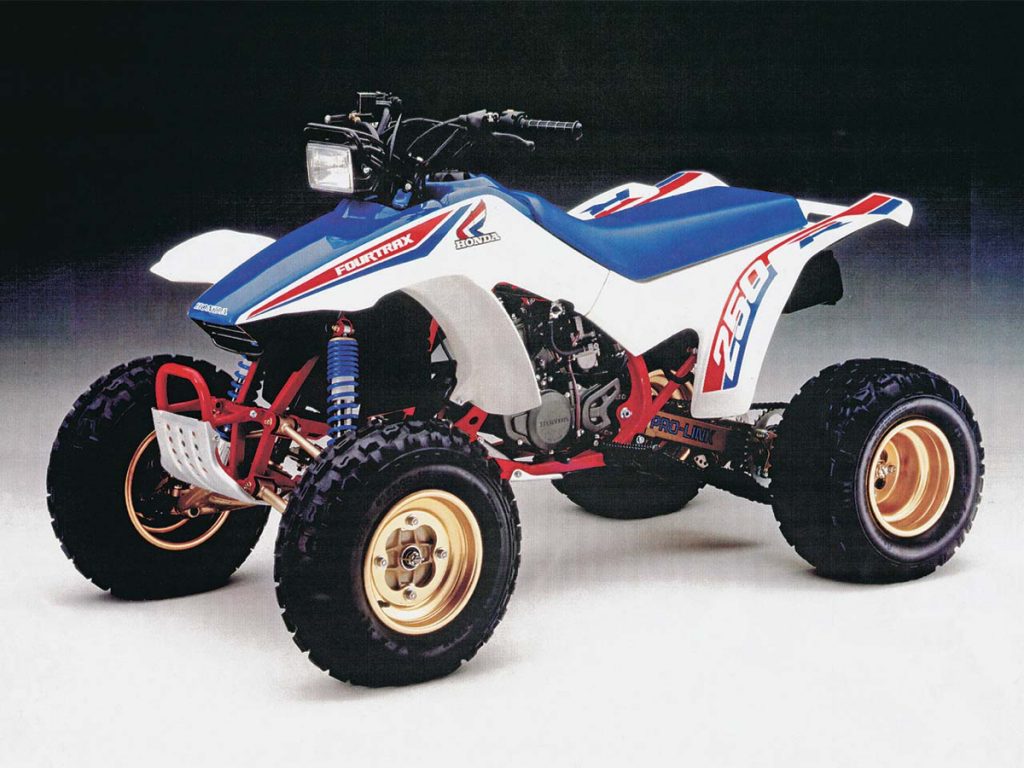
In 1986, Honda officially jumped on the quad bandwagon with a performance four-wheeler of their own. The new TRX250R Fourtrax shared much of its DNA with the ATC250R, but surpassed it in handling and ease-of-use.
In a contest of handling, the Honda evenly split the middle once again. On the aggressive end, you had the new Kawasaki, with exceedingly sharp turning and a low-slung layout. On the more sedate side was the Yamaha, with its long wheelbase and taller and flexier tires. This worked great in the desert and dunes, but made the Tri-Z feel tippy and more stubborn in the turns. In truth, the real loser this category was all of them, as none of the trikes could hold a candle to the Quadracer or new Fourtrax in this department.
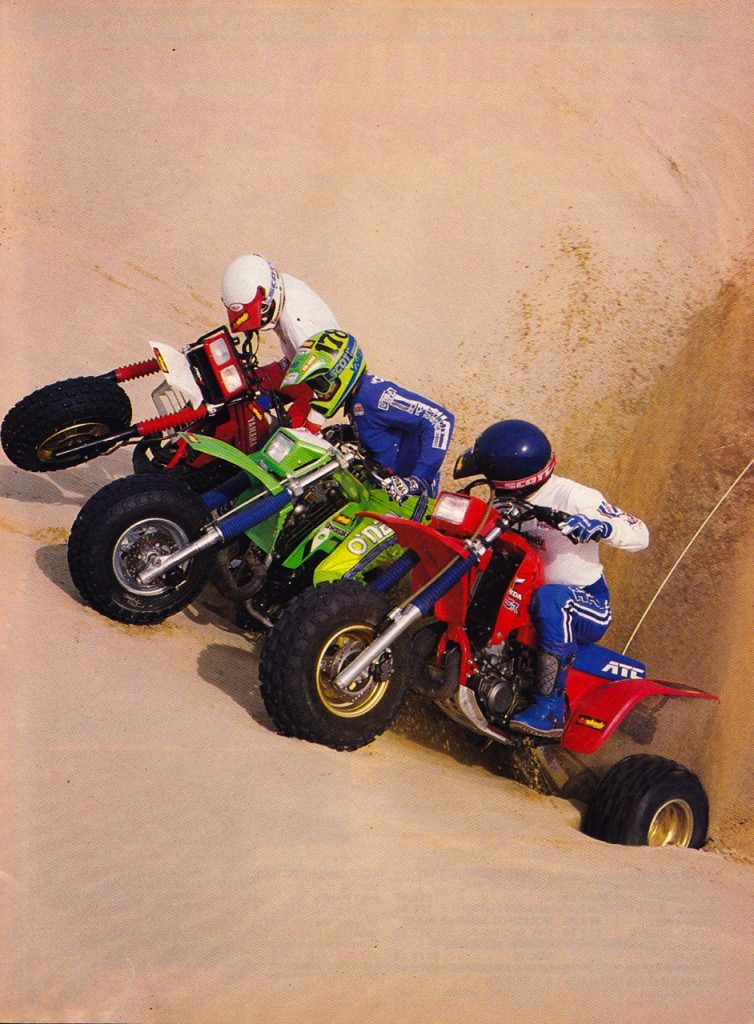 In 1986, the Honda ATC250R once again held the crown of best overall trike in the land. After ’86, only the Kawasaki would remain, as both Honda and Yamaha shifted their performance efforts toward four-wheeled machines. Photo Credit Dirt Wheels
In 1986, the Honda ATC250R once again held the crown of best overall trike in the land. After ’86, only the Kawasaki would remain, as both Honda and Yamaha shifted their performance efforts toward four-wheeled machines. Photo Credit Dirt Wheels
On the details front, the Honda ATC250R continued to be the class of the field. The dual-piston front and single-piston rear Nissin stoppers continued to provide the most power and demand the least maintenance in the class. All the controls were top notch, with sturdy levers, great grips and intuitive controls. The thumb throttle continued to be smooth in action, but some riders still preferred the conventional twist throttle found on the Tecate.
 In 1986, the real battle for ATV supremacy was among the two four-wheeled competitors. In the end, Honda’s new Fourtrax 250R dominated both its three and four-wheeled competition with an unmatched combination of handling, power and performance. Photo Credit: Dirt Rider
In 1986, the real battle for ATV supremacy was among the two four-wheeled competitors. In the end, Honda’s new Fourtrax 250R dominated both its three and four-wheeled competition with an unmatched combination of handling, power and performance. Photo Credit: Dirt Rider
Tire quality, shifting, clutch life and general fit and finish were also top notch on the Honda. The plastic also looked great, fit perfectly and did not crack in two on every ride like the incredibly brittle Kawasaki. With its counterbalancer, it also vibrated a hell of a lot less and did not require the bolt-tightening vigilance needed to keep the Tecate from shedding parts at inopportune moments.
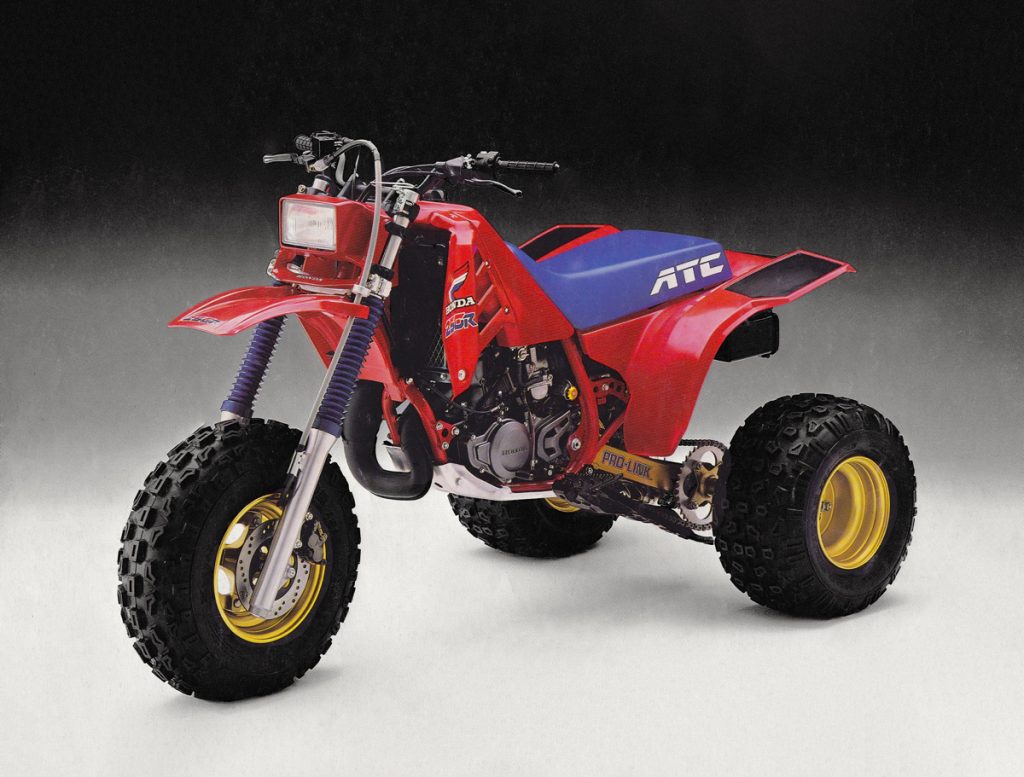 In 1986, Honda brought out its ultimate expression of three-wheeled performance. The 250R offered stellar looks, excellent suspension and broad power for those skilled enough to make use of its potential. For certain, it was a fitting end for the original performance ATV. Photo Credit: Honda
In 1986, Honda brought out its ultimate expression of three-wheeled performance. The 250R offered stellar looks, excellent suspension and broad power for those skilled enough to make use of its potential. For certain, it was a fitting end for the original performance ATV. Photo Credit: Honda
In 1986, Honda rolled out their ultimate expression of three-wheeled ATV performance. Sixteen years after introducing the world to the ATC, they closed out the era with a real winner. While it was not as outright fast as the racy Kawasaki Tecate, the ATC250R was a far better all-around machine. It offered excellent handling, broad power, exceptional suspension and unparalleled quality. It was as great a play bike as it was a racer, and that is a claim few machines of any kind can back up.
For your daily dose of old-school moto goodness, make sure to follow me on Twitter and Instagram – @TonyBlazier
For questions or comments, feel free to drop me a line anytime at TheMotocrossVault@Gmail.com




